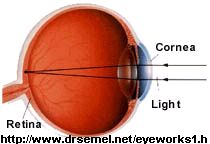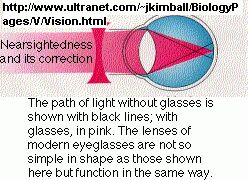Week 16 - Light Behaves in Predictable Ways
| Site: | MoodleHUB.ca 🍁 |
| Course: | Science 8 LearnNet |
| Book: | Week 16 - Light Behaves in Predictable Ways |
| Printed by: | Guest user |
| Date: | Monday, 17 November 2025, 5:54 PM |
Description
.
 |
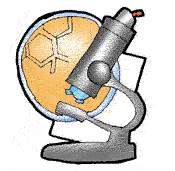 |
 |
Now that we've learned the scientific principles of refraction, we are going to study how these principles can be used to make our lives better.
In the last lesson we learned that as light passes through materials of differing density it refracts and moves in a slightly different direction. This knowledge has allowed us to build devices which enhance our lives. Let's examine some of them.
Lenses
A lens is a curved piece of material, usually glass or plastic, which refracts light and causes it to bend. There are two basic types of lenses: convex lenses and concave lenses.
The Convex Lens
A convex lens is fatter in the middle than at the edges.
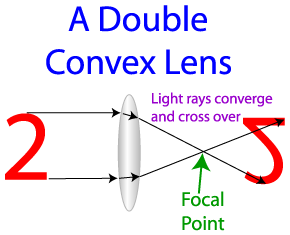 |
When light rays passes through a convex lens they come together, or converge, at some point. The place where they cross each other is called the focal point. By making the curvature of the lens larger or smaller you can change the focal point of the converging light. |
Many lenses have convex shapes on both sides of the lens. These are called double convex lenses. Because the light crosses over at the focal point, the image becomes inverted (upside down).
The distance to the focal point focal point depends on the distance from the object to the lens.
| Did You Know? What is the biggest lens you can think of? A large telescope perhaps? How about a lens made from groups of galaxies! That's right - galaxies. The lenses they make are called gravitational lenses. If you would you like to know more check out the following websites |
See a larger picture. |
The Concave Lens
| The concave lens is opposite from the convex lens in just about every way. A concave lens is thinner in the middle than at the edges. As light passes through the concave lens it diverges (spreads out). There is no focal point because the rays will never meet. |
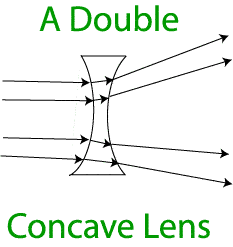 |
The Human Eye
Each of your eyes has a convex lens in it. The lens of your eye allows an image to focus on the retina (on back of your eye). But this living lens can change shape. This allows it to focus on objects near and far away. Muscles in your eye relax and contract to change the shape of the lens.
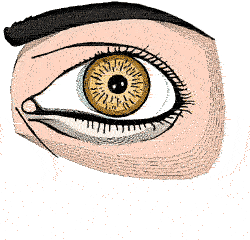 |
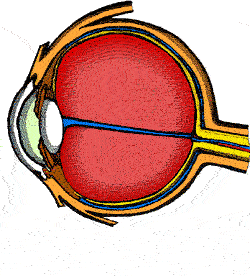 The lens is the white oval in this picture. |
But if the lens of the eye is so flexible why do people have to wear glasses? In the following activity you are going to conduct a small research project to answer that question. You will find your information on the Internet sites indicated in each question below.
![]() Exercise 2.1: You're the Eye Doctor
Exercise 2.1: You're the Eye Doctor
|
© 2002 Alberta Online Consortium
|
Lesson 6
|
Lesson 6: Lenses
Science in Action 8
Pages 204-208
© 2002 Alberta Online Consortium
|
Lesson 7
|
Lesson 7: Microscopes, Telescopes, and Binoculars
Science in Action 8
Pages 182-186, 221-226 Background Information A compound microscope is used to enlarge small objects. A convex objective lens forms an enlarged image that is further enlarged by an eyepiece lens.
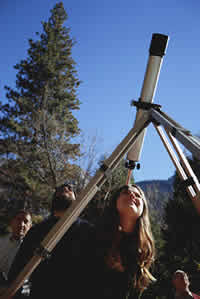 Some newer cameras use a lens to form an image on a light-sensitive sensor, and some oldder cameras form an image on light sensitive film. 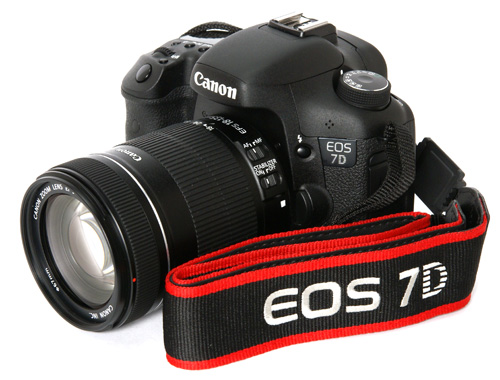 In this lesson, you will use a combination of your textbook and Internet web sites to learn more about these technological devices. Exercise 2.3: Microscopes and Binoculars © 2002 Alberta Online Consortium
|
Lesson 8
|
Lesson 8: Human Eyes and Cameras
Science in Action 8
Read pages 230 - 235
In earlier lessons, you learned how light waves are bent or refracted when they travel from one medium to another. You also discovered that a lens is a transparent object with at least one curved side that causes light to bend. The amount of bending can be controlled by making the sides of the lens more or less curved. The more curved the sides, the more a ray of light entering the lens is bent. As you will see in this lesson, the human eye has several structures that refract light. Your eye is a sense organ that captures the energy of light and converts this light energy into nervous impulses. The nervous impulses travel down a large nerve (the optic nerve) to your brain. The neurons in your brain interpret these nervous impulses into images such as the words and pictures on your computer monitor. Identify each part of the eyeball in Figure 1 as you read the next paragraph. Figure 1: Illustration of the eyeball
 Light travels in straight lines unless something bends or refracts it. Your eyes are equipped with structures that bend light. As light enters the eye, its waves are first bent by the cornea and then a lens. The lens directs the rays onto the retina. The retina is a tissue at the back of the eye that contains nerve cells that are sensitive to light energy. Two types of light sensitive cells called rods and cones are found in the retina. Cones respond to bright light and colour. Rods respond to dim light and are used to help you detect shape and movement. For example, when you go out at night, you usually do not see the colour of objects. You may make out the size and shape of the object but it is tough to tell the colours of dimly lit objects. This is because there is not enough energy in dim light to stimulate the cones. Light energy stimulates impulses in the rods and/or cones. The impulses pass to the optic nerve, which carries them to the brain. Neurons in the brain interpret the impulses and you "see" what you are looking at. The iris controls the amount of light entering your eyeball. In dim light, your iris opens allowing more light to enter. In bright light, your iris closes allowing less light to enter your eye. Your pupil is the opening in the iris. It really isn't a structure and what you "see" when you look into someone's pupil is the dark layer at the back of the eyeball. Lenses Light is refracted, or bent when it passes through a lens. Just how it bends depends on the type of lens it passes through. In a previous lesson, you learned that a lens that is thicker in the middle and thinner on the edges is called a convex lens. The lens in your eye is convex. A convex lens causes parallel light rays entering your eye to come together (converge) at a focal point. A lens that has thicker edges than the middle is called a concave lens. The parallel light waves passing though a concave lens are spread out.
Cameras A typical film camera has a convex lens that forms an image on a section of light sensitive film. Once again, a convex lens forms an image that is smaller and is upside down if the object is more than two focal lengths away. A camera lens is a convex lens used in this way. When the shutter of a camera is open, the convex lens forms an image on a piece of film that is sensitive to light. The film contains chemicals that undergo chemical reactions when struck by light. This causes light areas and darks areas in the image to be recorded. If the film is sensitive to colour, the colours of the object are also recorded. An image that is too bright may overexpose the film. If there is too little light that reaches the film, the image may be too dark. A diaphragm is a device in a camera that controls the amount of light that reaches the film. The iris (colour part) performs a similar job in your eye. For more information the eye go to The Human Eye web site. Exercise 2.4: Eye vs Camera © 2002 Alberta Online Consortium
|
You will have two opportunities to write this section quiz. This quiz consists of 10 questions. Use the results from your 1st attempt to help you prepare for your second attempt. Your best score will be taken as your assessment mark. You have 30 minutes to complete this multiple choice quiz.
Click the icon to go to the quiz.





